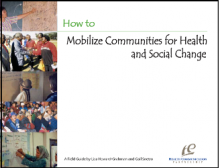Comment mobiliser les communautés au changement social et en matière de santé
Comment mobiliser les communautés au changement social et en matière de santé
Comment mobiliser les communautés au changement social et en matière de santé
A how-to guide to mobilizing communities. Features lessons in: organizing communication, planning, acting, and evaluating efforts.
This field guide has been designed to be used by health program directors and managers of community-based programs who are considering using community mobilization to improve health at the individual, family, and community level. It may also be useful for directors and technicians in governmental and nongovernmental organizations working in public health and human development and other groups and organizations committed to community health, such as churches, universities, philanthropists, and donors. No prior community mobilization experience is required to use the field guide.
The field guide contains illustrative examples and lessons learned in community mobilization experiences from around the world, focusing on working with disadvantaged or marginalized groups in developing countries. The characteristics of each country and each region are very different, so the field guide does not recommend one specific strategy for community mobilization but offers instead general principles and methods which will need to be adapted to local settings and conditions.
How to Mobilize Communities for Health and Social Change
Year of Publication: 2003
Languages: English
This site was originally developed by the Health Communication Capacity Collaborative (Cooperative Agreement #AID-OAA-A-12-00058) and expanded under Breakthrough ACTION (Cooperative Agreement #AID-OAA-A-17-00017) both under the leadership of Johns Hopkins Center for Communication Programs (CCP). This website is now maintained by CCP and its contents are the sole responsibility of CCP. The contents of this website do not necessarily reflect the views of USAID, the United States Government, or Johns Hopkins University.
